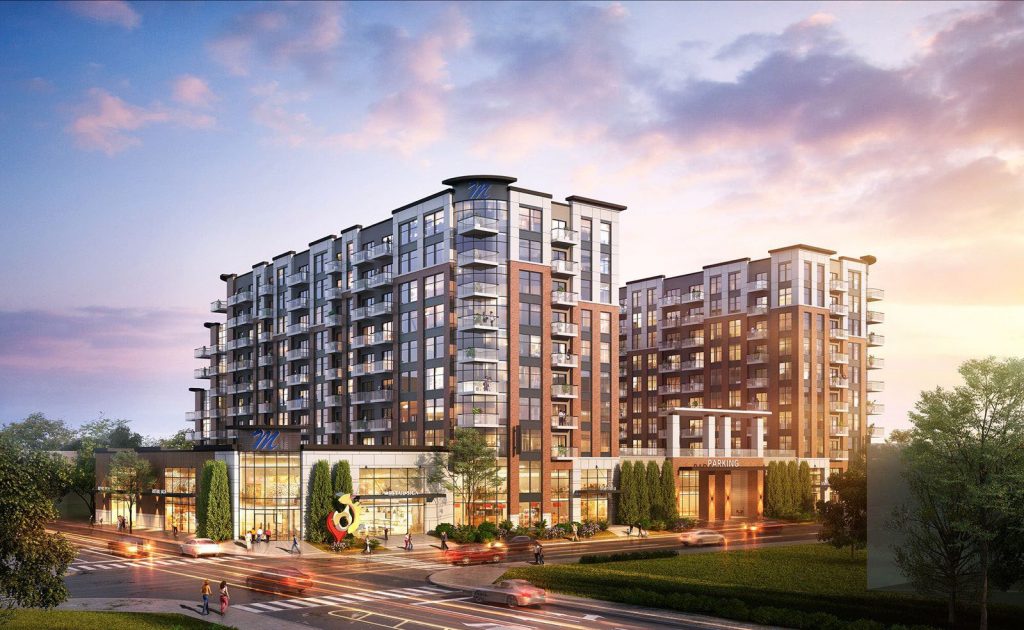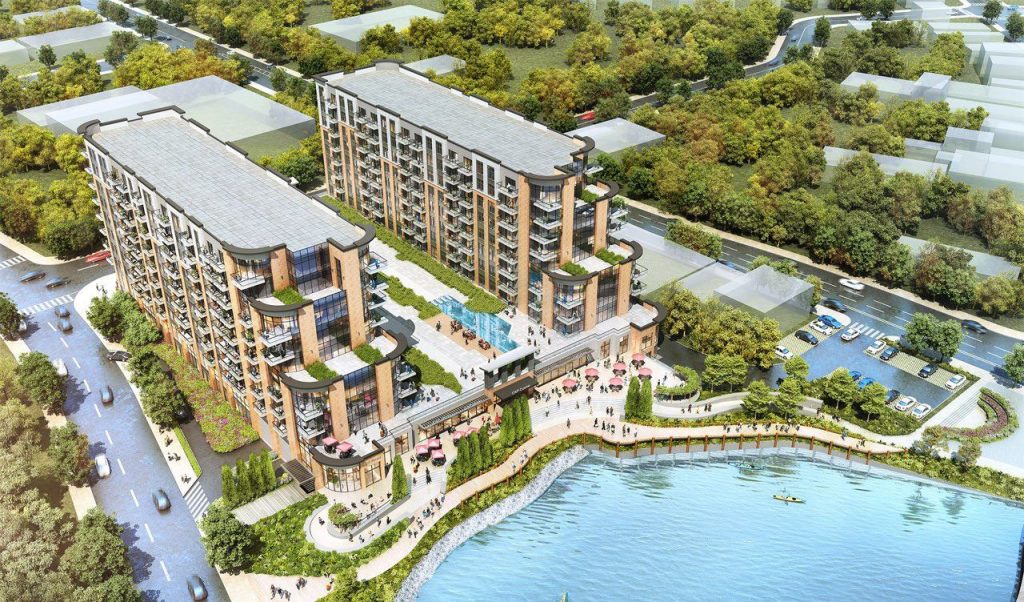
A proposed mixed-use redevelopment project proposed for Water Street in downtown Toms River. (Photo: Toms River Township)
A plan to redevelop a portion of downtown Toms River with a 10-story, 285-unit high rise complex has elicited support from the local business community and some elected officials, but many residents told the township council that large scale development is out of character for the suburban community, while also expressing discontent with the tax abatement planned for the potential developer.
While the plan to contract with the Capodagli Group to refresh a portion of the downtown waterfront district – the site of the former Red Carpet Motel and a public parking lot – has been under consideration in one form or another since 2011, the township council was tasked Tuesday night with final execution of the redevelopment agreement and the transfer of land parcels. The plan, as currently proposed, consists of two towers that will stand 10 stories tall and, between both, will feature 285 apartments that will be a mix of studio, one-bedroom and two-bedroom units. About 43 units would be set aide for designated affordable housing under state law, and half of those would be first made available to those who would qualify for a veterans’ preference. The complex would also feature retail and restaurant space, plus a waterfront park and walkway that would be open to the public.
The vote to appoint the developer, which was ultimately tabled for two weeks, led to a packed council chamber on Tuesday night. More than a dozen residents and business owners spoke, with the primary concern being the size of the buildings. But once more information merged about the tax abatement that had been negotiated by Capodagli, the focus of residents’ ire gradually evolved to envelope the financial ramifications of the project.
Pros and Cons
Business leaders, including representatives from the Downtown Toms River Business Improvement District and the Greater Toms River Chamber of Commerce, voiced support for the development, holding that the addition of a major mixed-use complex would add hundreds of residents to the downtown area, create demand for small businesses and lead to additional high-end redevelopment projects.

A proposed mixed-use redevelopment project proposed for Water Street in downtown Toms River. (Photo: Toms River Township)
“This is an economic driver for Toms River,” said redevelopment attorney Joseph Baumann. “Getting someone to submit a bid and take a chance on Toms River is the biggest hurdle. The first project is the one that creates the impetus for more development – there will be a lot of wallets that aren’t here today.”
A representative from Community Medical Center also spoke, endorsing the project because it would provide additional housing for the hospital’s fledgling physician residency program. Capodagli has courted support from the local medical community by pledging to offer discounts and incentives to hospital workers and first responders.
Residents who spoke at the meeting were generally opposed to the project, expressing concerns over the changing character of the downtown district, tax breaks for the developer, traffic issues and the affect such development would have on the township’s school district.
The plan currently under consideration would see Capodagli acquiring one parcel of land required for the project – owned by the Toms River Parking Authority – for $560,000. The former motel property would be sold to the company for $1. The motel property was purchased by taxpayers for $3.3 million. Though the value of the property is expected to be assessed in the tens of millions of dollars, Capodagli would be responsible for just $392,747 in tax obligations each year under a payment in lieu of taxes, or PILOT, plan. Commonly known as a tax abatement, PILOTs are normally used to lure developers to blighted properties that would not otherwise garner investment. Of that revenue, 5 percent is dedicated to the county while 90 percent flows to the municipal government. None of the revenue is required to be remitted to the school district, though the township council could voluntarily transfer a portion of the funds each year.
The overall size of the building captured residents’ attention first. The building would be a largest residential building in town and, likely, the largest in Ocean County. It would rise more than 100-feet tall, though Township Planner Dave Roberts said the properties in question are located in the lowest elevation point in Toms River and would not appear overly large to those in the greater downtown area.
“The area where the buildings are proposed is the lowest point of the township – only 3 to 4 feet above sea level,” Roberts explained, adding that government buildings such as the court complex and jail could appear even taller to the naked eye. “Even though they’re not as tall, the relative heights are comparable.”
Much of the downtown area has an elevation of 15-feet above sea level.
The complex would be built atop business space and a two-story parking deck with 411 spaces. It complies with all modern flood zone regulations and environmental policies, which representatives said increase the cost of the project significantly, necessitating the tax abatement.
The apartments would be marketed toward millennials and other singles or couples without children. Capodagli would also target the hospital residents as well as hundreds of new employees expected in town to work at the OceanFirst corporate headquarters, the planned VA clinic and the expanded Ocean County social services building. A demographic study conducted by Rutgers University estimated that between 25 and 50 children would live in the complex, mainly in the designated affordable housing units. Studio apartments would be priced at $1,275 per month, with rental rates rising to $1,875 for a two-bedroom unit.
“The market is growing for these units and we are very comfortable that the project will be successful,” said Roberts. “They’ve already spent hundreds of thousands of dollars getting to this evening, and we don’t think there is a concern in that regard.”
Additional perks of living in the building will include the use of co-working space, a gym, restaurants and a coffee shop. A jitney will also run between the building and the Toms River bus terminal as well as the hospital.
Some residents were not convinced that the project would equate to a net-positive for the township.
“If there is just one student with special needs, that can cost over $100,000,” said Michelle Williams, who serves on the local school board.
Other residents stated that the complex would transform Toms River from a suburban community to a higher-density urban community. One downtown resident said she moved to Toms River because it was quieter than Asbury Park, Red Bank and other municipalities that were held up as examples of communities that have successfully undertaken redevelopment efforts.
Regarding the size of the building, Councilwoman Laurie Huryk said the height is arguably more friendly to the environment.
“This is an opportunity to take up a smaller footprint,” she said. “It’s actually having the effect of helping us preserve more open space.”
Baumann, for his part, said the redeveloper would not be interested in completing the project without the PILOT program. Therefore, he opined, that comparisons of the annual payment to the normal tax obligation of a building valued at the same level are unfair.
“The PILOT is integral – the project doesn’t get done without that,” he said. “It’s a tool that will allow this project to succeed because of the extraordinary costs associated with it, partially the affordable housing requirements, partially the deck and partially the DEP permitting. This is the number that will allow the project to get built without creating a windfall for the developer.”
The annual payment is calculated by estimating a 7 percent portion of gross revenues. The payment would rise over time as rent prices increase, however the percentage is fixed for 30 years.
“We’re giving up some taxes and the property for the building and the residents,” said Councilman Matthew Lotano.
Baumann did not mince words.
“We need to have a first one, and the first one is usually more expensive,” he said.
The plan was primarily questioned by Councilman Dan Rodrick, who expressed frustration over the tax abatement and the fact that a property purchased for $3.3 million by the township is being resold for just $1.
“Just from the cost of schooling, this building is going to cost taxpayers more than $300,000 per year,” he said.
At the urging of residents, as well as Rodrick and Councilman Terrence Turnbach, the council agreed to table the vote on the appointment of Capodagli as redeveloper and land transfer until the next meeting of the governing body, scheduled for Aug. 24.


Police, Fire & Courts
Prosecutors: Toms River Man, 28 Doxxed and Arrested After Traveling to Meet Minor Abroad

Police, Fire & Courts
Cops: Toms River Man, 59, Set House on Fire

Police, Fire & Courts
Ocean County Drug Dealer Gets 11 Year Sentence Following Guilty Plea

Police, Fire & Courts
Ocean County Drug Dealer Gets 11 Year Sentence Following Guilty Plea

Police, Fire & Courts
Prosecutors: Toms River Man, 28 Doxxed and Arrested After Traveling to Meet Minor Abroad





